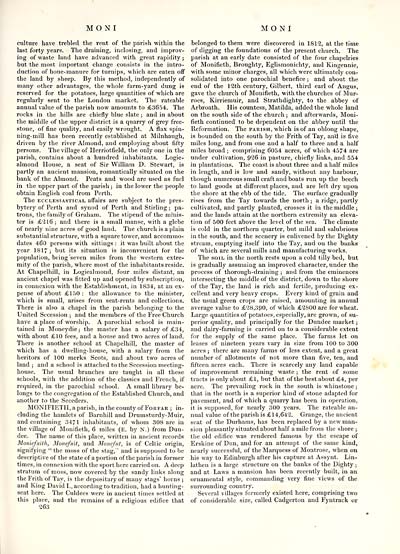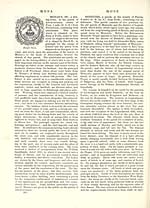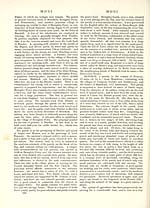Topographical dictionary of Scotland > Volume 2
(271) Page 263
Download files
Complete book:
Individual page:
Thumbnail gallery: Grid view | List view

M O N I
MONI
culture have trebled the rent of the parish within the
last forty years. The draining, inclosing, and improv-
ing of waste land have advanced with great rapidity ;
but the most important change consists in the intro-
duction of bone-manure for turnips, which are eaten off
the land by sheep. By this method, independently of
many other advantages, the whole farm-yard dung is
reserved for the potatoes, large quantities of which are
regularly sent to the London market. The rateable
annual value of the parish now amounts to £3654. The
rocks in the hills are chiefly blue slate ; and in about
the middle of the upper district is a quarry of grey free-
stone, of fine quality, and easily wrought. A flax spin-
ning-mill has been recently established at Milnhaugh,
driven by the river Almond, and employing about fifty
persons. The village of Herriotfield, the only one in the
parish, contains about a hundred inhabitants. Logic-
almond House, a seat of Sir William D. Stewart, is
partly an ancient mansion, romantically situated on the
bank of the Almond. Peats and wood are used as fuel
in the upper part of the parish ; in the lower the people
obtain English coal from Perth.
The ecclesiastical affairs are subject to the pres-
bytery of Perth and synod of Perth and Stirling; pa-
trons, the family of Graham. The stipend of the minis-
ter is £"216; and there is a small manse, with a glebe
of nearly nine acres of good land. The church is a plain
substantial structure, with a square tower, and accommo-
dates 460 persons with sittings : it was built about the
year 1817 \ but its situation is inconvenient for the
population, being seven miles from the western extre-
mity of the parish, where most of the inhabitants reside.
At Chapelhill, in Logiealmond, four miles distant, an
ancient chapel was fitted up and opened by subscription,
in connexion with the Establishment, in 1834, at an ex-
pense of about £150: the allowance to the minister,
which is small, arises from seat-rents and collections.
There is also a chapel in the parish belonging to the
United Secession ; and the members of the Free Church
have a place of worship. A parochial school is main-
tained in Moneydie ; the master has a salary of £34,
with about £10 fees, and a house and two acres of land.
There is another school at Chapelhill, the master of
which has a dwelling-house, with a salary from the
heritors of 100 merks Scots, and about two acres of
land : and a school is attached to the Secession meeting-
house. The usual branches are taught in all these
schools, with the addition of the classics and French, if
required, in the parochial school. A small library be-
longs to the congregation of the Established Church, and
another to the Seceders.
MONIFIETH, a parish, in the county of Forfar ; in-
cluding the hamlets of Barnhill and Drumsturdy-Muir,
and containing 3471 inhabitants, of whom 308 are in
the village of Monifieth, 6 miles (E. by N.) from Dun-
dee. The name of this place, written in ancient records
Mordefaith, Monefuit, and Monefut, is of Celtic origin,
signifying "the moss of the stag,'' and is supposed to be
descriptive of the state of a portion of the parish in former
times, in connexion with the sport here carried on. A deep
stratum of moss, now covered by the sandy links along
the Frith of Tay, is the depositary of many stags' horns ;
and King David I., according to tradition, had a hunting-
seat here. The Culdees were in ancient times settled at
this place, and the remains of a religious edifice that
263
belonged to them were discovered in 1812, at the time
of digging the foundations of the present church. The
parish at an early date consisted of the four chapelries
of Monifieth, Broughty, Eglismonichty, and Kingennie,
with some minor charges, all which were ultimately con-
solidated into one parochial benefice ; and about the
end of the 12th century, Gilbert, third earl of Angus,
gave the church of Monifieth, with the churches of Mur-
roes, Kirriemuir, and Strathdighty, to the abbey of
Arbroath. His countess, Matilda, added the whole land
on the south side of the church ; and afterwards, Moni-
fieth continued to be dependent on the abbey until the
Reformation. The parish, which is of an oblong shape,
is bounded on the south by the Frith of Tay, and is five
miles long, and from one and a half to three and a half
miles broad ; comprising 6054 acres, of which 4574 are
under cultivation, 926 in pasture, chiefly links, and 554
in plantations. The coast is about three and a half miles
in length, and is low and sandy, without any harbour,
though numerous small craft and boats run up the beech
to land goods at different places, and are left dry upon
the shore at the ebb of the tide. The surface gradually
rises from the Tay towards the north ; a ridge, partly
cultivated, and partly planted, crosses it in the middle ;
and the lands attain at the northern extremity an eleva-
tion of 500 feet above the level of the sea. The climate
is cold in the northern quarter, but mild and salubrious
in the south, and the scenery is enlivened by the Dighty
stream, emptying itself into the Tay, and on the banks
of which are several mills and manufacturing works.
The soil in the north rests upon a cold tilly bed, but
is gradually assuming an improved character, under the
process of thorough-draining ; and from the eminences
intersecting the middle of the district, down to the shore
of the Tay, the land is rich and fertile, producing ex-
cellent and very heavy crops. Every kind of grain and
the usual green crops are raised, amounting in annual
average value to £28,390, of which £2S00 are for wheat.
Large quantities of potatoes, especially, are grown, of su-
perior quality, and principally for the Dundee market ;
and dairy-farming is carried on to a considerable extent
for the supply of the same place. The farms let on
leases of nineteen years vary in size from 100 to 300
acres ; there are many farms of less extent, and a great
number of allotments of not more than five, ten, and
fifteen acres each. There is scarcely any land capable
of improvement remaining waste ; the rent of some
tracts is only about £1, but that of the best about £4, per
acre. The prevailing rock in the south is whinstone ;
that in the north is a superior kind of stone adapted for
pavement, and of which a quarry has been in operation,
it is supposed, for nearly 300 years. The rateable an-
nual value of the parish is £14,642. Grange, the ancient
seat of the Durhams, has been replaced by a new man-
sion pleasantly situated about half a mile from the shore ;
the old edifice was rendered famous by the escape of
Erskine of Dun, and for an attempt of the same kind,
nearly successful, of the Marquess of Montrose, when on
his way to Edinburgh after his capture at Assynt. Lin-
lathen is a large structure on the banks of the Dighty ;
and at Laws a mansion has been recently built, in an
ornamental style, commanding very fine views of the
surrounding country.
Several villages formerly existed here, comprising two
of considerable size, called Cadgerton and Fyntrack or
MONI
culture have trebled the rent of the parish within the
last forty years. The draining, inclosing, and improv-
ing of waste land have advanced with great rapidity ;
but the most important change consists in the intro-
duction of bone-manure for turnips, which are eaten off
the land by sheep. By this method, independently of
many other advantages, the whole farm-yard dung is
reserved for the potatoes, large quantities of which are
regularly sent to the London market. The rateable
annual value of the parish now amounts to £3654. The
rocks in the hills are chiefly blue slate ; and in about
the middle of the upper district is a quarry of grey free-
stone, of fine quality, and easily wrought. A flax spin-
ning-mill has been recently established at Milnhaugh,
driven by the river Almond, and employing about fifty
persons. The village of Herriotfield, the only one in the
parish, contains about a hundred inhabitants. Logic-
almond House, a seat of Sir William D. Stewart, is
partly an ancient mansion, romantically situated on the
bank of the Almond. Peats and wood are used as fuel
in the upper part of the parish ; in the lower the people
obtain English coal from Perth.
The ecclesiastical affairs are subject to the pres-
bytery of Perth and synod of Perth and Stirling; pa-
trons, the family of Graham. The stipend of the minis-
ter is £"216; and there is a small manse, with a glebe
of nearly nine acres of good land. The church is a plain
substantial structure, with a square tower, and accommo-
dates 460 persons with sittings : it was built about the
year 1817 \ but its situation is inconvenient for the
population, being seven miles from the western extre-
mity of the parish, where most of the inhabitants reside.
At Chapelhill, in Logiealmond, four miles distant, an
ancient chapel was fitted up and opened by subscription,
in connexion with the Establishment, in 1834, at an ex-
pense of about £150: the allowance to the minister,
which is small, arises from seat-rents and collections.
There is also a chapel in the parish belonging to the
United Secession ; and the members of the Free Church
have a place of worship. A parochial school is main-
tained in Moneydie ; the master has a salary of £34,
with about £10 fees, and a house and two acres of land.
There is another school at Chapelhill, the master of
which has a dwelling-house, with a salary from the
heritors of 100 merks Scots, and about two acres of
land : and a school is attached to the Secession meeting-
house. The usual branches are taught in all these
schools, with the addition of the classics and French, if
required, in the parochial school. A small library be-
longs to the congregation of the Established Church, and
another to the Seceders.
MONIFIETH, a parish, in the county of Forfar ; in-
cluding the hamlets of Barnhill and Drumsturdy-Muir,
and containing 3471 inhabitants, of whom 308 are in
the village of Monifieth, 6 miles (E. by N.) from Dun-
dee. The name of this place, written in ancient records
Mordefaith, Monefuit, and Monefut, is of Celtic origin,
signifying "the moss of the stag,'' and is supposed to be
descriptive of the state of a portion of the parish in former
times, in connexion with the sport here carried on. A deep
stratum of moss, now covered by the sandy links along
the Frith of Tay, is the depositary of many stags' horns ;
and King David I., according to tradition, had a hunting-
seat here. The Culdees were in ancient times settled at
this place, and the remains of a religious edifice that
263
belonged to them were discovered in 1812, at the time
of digging the foundations of the present church. The
parish at an early date consisted of the four chapelries
of Monifieth, Broughty, Eglismonichty, and Kingennie,
with some minor charges, all which were ultimately con-
solidated into one parochial benefice ; and about the
end of the 12th century, Gilbert, third earl of Angus,
gave the church of Monifieth, with the churches of Mur-
roes, Kirriemuir, and Strathdighty, to the abbey of
Arbroath. His countess, Matilda, added the whole land
on the south side of the church ; and afterwards, Moni-
fieth continued to be dependent on the abbey until the
Reformation. The parish, which is of an oblong shape,
is bounded on the south by the Frith of Tay, and is five
miles long, and from one and a half to three and a half
miles broad ; comprising 6054 acres, of which 4574 are
under cultivation, 926 in pasture, chiefly links, and 554
in plantations. The coast is about three and a half miles
in length, and is low and sandy, without any harbour,
though numerous small craft and boats run up the beech
to land goods at different places, and are left dry upon
the shore at the ebb of the tide. The surface gradually
rises from the Tay towards the north ; a ridge, partly
cultivated, and partly planted, crosses it in the middle ;
and the lands attain at the northern extremity an eleva-
tion of 500 feet above the level of the sea. The climate
is cold in the northern quarter, but mild and salubrious
in the south, and the scenery is enlivened by the Dighty
stream, emptying itself into the Tay, and on the banks
of which are several mills and manufacturing works.
The soil in the north rests upon a cold tilly bed, but
is gradually assuming an improved character, under the
process of thorough-draining ; and from the eminences
intersecting the middle of the district, down to the shore
of the Tay, the land is rich and fertile, producing ex-
cellent and very heavy crops. Every kind of grain and
the usual green crops are raised, amounting in annual
average value to £28,390, of which £2S00 are for wheat.
Large quantities of potatoes, especially, are grown, of su-
perior quality, and principally for the Dundee market ;
and dairy-farming is carried on to a considerable extent
for the supply of the same place. The farms let on
leases of nineteen years vary in size from 100 to 300
acres ; there are many farms of less extent, and a great
number of allotments of not more than five, ten, and
fifteen acres each. There is scarcely any land capable
of improvement remaining waste ; the rent of some
tracts is only about £1, but that of the best about £4, per
acre. The prevailing rock in the south is whinstone ;
that in the north is a superior kind of stone adapted for
pavement, and of which a quarry has been in operation,
it is supposed, for nearly 300 years. The rateable an-
nual value of the parish is £14,642. Grange, the ancient
seat of the Durhams, has been replaced by a new man-
sion pleasantly situated about half a mile from the shore ;
the old edifice was rendered famous by the escape of
Erskine of Dun, and for an attempt of the same kind,
nearly successful, of the Marquess of Montrose, when on
his way to Edinburgh after his capture at Assynt. Lin-
lathen is a large structure on the banks of the Dighty ;
and at Laws a mansion has been recently built, in an
ornamental style, commanding very fine views of the
surrounding country.
Several villages formerly existed here, comprising two
of considerable size, called Cadgerton and Fyntrack or
Set display mode to: Large image | Transcription
Images and transcriptions on this page, including medium image downloads, may be used under the Creative Commons Attribution 4.0 International Licence unless otherwise stated. ![]()
| Gazetteers of Scotland, 1803-1901 > Topographical dictionary of Scotland > Volume 2 > (271) Page 263 |
|---|
| Permanent URL | https://digital.nls.uk/97364382 |
|---|
| Description | Volume II: From Keanlochbervie to Zetland. |
|---|---|
| Attribution and copyright: |
|

